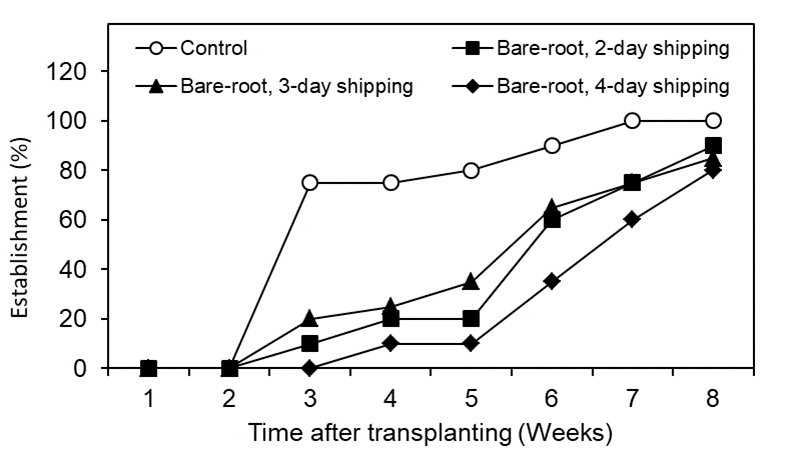ผลของระยะเวลาในการขนส่งกิ่งปักชำมะกรูดล้างรากต่อการตั้งตัวหลังการย้ายปลูก | Effect of Shipping Duration of Kaffir Lime Bare-root Cuttings on their Establishment after Transplanting
Main Article Content
Abstract
The effect of shipping duration for 2, 3 and 4 days by parcel post service on the establishment of kaffir lime bare-root cuttings after transplanting was studied. The bare-root cuttings were wrapped in moist newspaper, inserted into a plastic bag, 20 cuttings/bag and packed into a parcel paper box of 24 x 40 x 17 cm dimension. These parcel boxes were shipped to the destination by car in one day and left under shade without temperature and relative humidity control until reaching the tested shipping duration. Rooted cuttings with rooting media intact being shipped to the destination and transplanted on the same day were served as the control for comparison. It was found that weight/unit of bare-root cuttings was 50 times less than that of the control. After transplanting for 8 weeks, all the cuttings in the control set survived and produced new shoots. Their new shoots were 9.5 cm long with 12.6 leaves/plant and leaf greenness values of 55.3 SPAD unit. Dry weight of shoots and roots of the control was 14.4 g and 1.6 g, respectively, with the root to shoot ratio of 0.12. The bare-root cuttings undergone different shipping duration had 95 – 100% survival rate after transplanting for 8 weeks. Their new shoots emerged slower than those of the control, and 80 – 90% of the bare-root cuttings produced new shoots. Their new shoots were 8.0 – 9.0 cm long with 6.9 – 8.5 leaves/plant and leaf greenness values between 50.5 – 68.2 SPAD unit. The dry weight of shoots and roots of these plants was 6.8 – 9.9 g and 0.8 – 1.4 g, respectively, with the root to shoot ratio of 0.13 – 0.14. Shipping of bare-root cuttings by parcel post service within 2 days was feasible with minimal negative impact on their establishment after transplanting. Increasing of shipping duration delayed shoot emergence and reduced overall growth of bare-root cuttings after transplanting.
บทคัดย่อ
ศึกษาผลของการขนส่งกิ่งปักชำมะกรูดล้างรากทางพัสดุไปรษณีย์เป็นระยะเวลา 2 3 และ 4 วันต่อการตั้งตัวหลังการย้ายปลูก โดยหุ้มกิ่งปักชำที่ผ่านการล้างวัสดุปักชำออกจากรากจนหมดด้วยกระดาษหนังสือพิมพ์ชื้น และถุงพลาสติก 20 กิ่ง/ห่อ แล้วบรรจุลงในกล่องพัสดุไปรษณีย์กระดาษขนาด 24 x 40 x 17 ซม. จำลองสภาพขนส่งกล่องพัสดุทางรถยนต์จากสวนมายังที่หมายและวางกล่องพัสดุในที่ร่ม ไม่ควบคุมอุณหภูมิและความชื้นสัมพัทธ์ ตามระยะเวลาที่กำหนด จึงทำการย้ายปลูก เปรียบเทียบกับกิ่งปักชำชุดควบคุมที่ไม่ได้ล้างวัสดุปักชำออกจากราก ที่ย้ายปลูกทันทีเมื่อขนส่งถึงที่หมายภายในวันเดียวกัน พบว่ากิ่งปักชำล้างรากมีน้ำหนักต่อหน่วยน้อยกว่ากิ่งปักชำชุดควบคุมถึง 50 เท่า หลังการย้ายปลูก 8 สัปดาห์พบว่า กิ่งปักชำชุดควบคุมทั้งหมดรอดตาย และมีการผลิใบใหม่ กิ่งใหม่ที่เกิดขึ้นมีความยาว 9.5 ซม. มีจำนวนใบใหม่ 12.6 ใบ/ต้น มีค่าความเขียวใบ 55.3 SPAD unit น้ำหนักแห้งของส่วนเหนือดินและส่วนรากเท่ากับ 14.4 และ 1.6 ก. และมีอัตราส่วนรากต่อยอดเท่ากับ 0.12 ส่วนกิ่งปักชำล้างรากที่ผ่านการขนส่งเป็นเวลาแตกต่างกัน มีจำนวนต้นรอดตาย 95 – 100% และ 80 – 90% ของต้นที่รอดตายตั้งตัวได้และมีการผลิยอดใหม่ กิ่งใหม่มีความยาว 8.0 – 9.0 ซม.
มีจำนวนใบใหม่ 6.9 – 8.5 ใบ/ต้น มีค่าความเขียวใบระหว่าง 50.5 – 68.2 SPAD Unit น้ำหนักแห้งของส่วนเหนือดิน และส่วนรากเท่ากับ 6.8 – 9.9 ก. และ 0.8 – 1.4 ก. และมีอัตราส่วนรากต่อยอดระหว่าง 0.13 – 0.14 การขนส่งกิ่งปักชำมะกรูดล้างรากทางพัสดุไปรษณีย์ภายใน 2 วัน มีผลกระทบน้อยต่อการรอดตายและการตั้งตัวหลังย้ายปลูกเมื่อเปรียบเทียบกับกิ่งปักชำในชุดควบคุม ระยะเวลาขนส่งที่นานขึ้นทำให้มีการผลิยอดใหม่ช้าและการเติบโตโดยรวมช้าลงหลังการย้ายปลูก
Downloads
Article Details
References
รวี เสรฐภักดี สามารถ เศรษฐวิทยา และสุขะวัฒน์ ทองเหลี่ยว. (2558). การผลิตใบมะกรูดเชิงการค้า. เอกสารวิชาการลำดับที่ 2, ศูนย์วิจัยและพัฒนาไม้ผลเขตร้อน. (น. 3). นครปฐม: ภาควิชาพืชสวน คณะเกษตร กำแพงแสน มหาวิทยาลัยเกษตรศาสตร์.
อโนทัย ไชยแสนชมภู. (2539). ผลของวัสดุหีบห่อและระยะเวลาการเก็บรักษาต่ออัตราการรอดตายของต้นกล้าผักหวานป่าที่มีการถอนย้ายแบบเปลือยราก. ปัญหาพิเศษปริญญาบัณฑิต, มหาวิทยาลัยเกษตรศาสตร์.
Buckstrup, M., & N. L. Bassuk. (2009). Creating the Urban Forest: The Bare Root Method. Urban Horticulture Institute. (p. 16). Ithaca, New York: Department of Horticulture, Cornell University.
Burdett, A. N. and D. G. Simpson.1984. Lifting, grading, packaging and storing, pp. 227 – 234, In M. L. Duryea and T. D. Landis (Ed), Forest Nursery Manual: Production of Bareroot Seedlings. The Netherlands: Martius Nijhoff/Dr. W. Junk Publisher.
Cannell, M. G. R., Tabbush, P. M., Deans, J. D., Hollingsworth, M. K., Sheppard, L. J., Philipson, J. J., & Murray, M. B. (1990). Sitka spruce and Douglas fir seedlings in the nursery and in cold storage: root growth potential, carbohydrate content, dormancy, frost hardiness and mitotic index. Forestry: An International Journal of Forest Research, 63(1), 9-27.
McKay, H. M., & White, M. S. (1997). Fine root electrolyte leakage and moisture content: indices of Sitka spruce and Douglas-fir seedling performance after desic-cation. New Forests, 13(1), 139-162.
Purer, O., & Mayak, S. (1988, March). Pelargonium cuttings-Effect of growth regulators. In IV International Symposium on Postharvest Physiology of Ornamental Plants 261 (pp. 347-354).
Rapaka, V. K., Faust, J. E., Dole, J. M., & Runkle, E. S. (2008). Endogenous carbohydrate status affects postharvest ethylene sensitivity in relation to leaf senescence and adventitious root formation in Pelargo-
nium cuttings. Postharvest biology and technology, 48(2), 272-282.
Schuch, U. K., Pemberton, H. B., & Kelly, J. J. (2007). Postharvest moisture loss from bare-root roses affects performance of containerized plants. HortScience, 42(3), 622-625.
Scianna, J. D., Logar, R., & Ogle, D. (2005). Temporary storage and handling of container, bareroot, and cutting stock. USDA Natural Resources Conservation Service, Idaho, Technical Note–Plant Materials–ID, 45(6).
Wang, Y. T. (2007). Temperature, duration in simulated shipping, and thermal acclimatization on the development of chilling injury and subsequent flowering of Phalaenopsis. Journal of the American Society for Horticultural Science, 132(2), 202-207.

